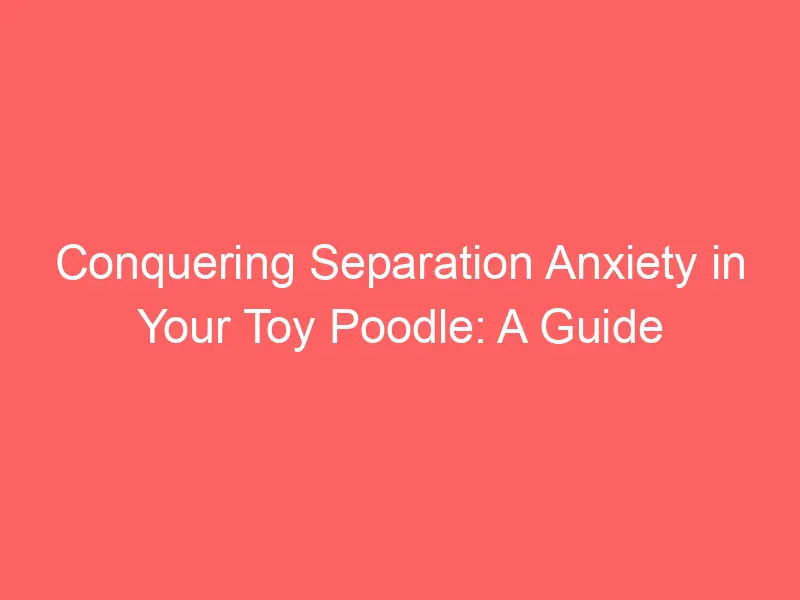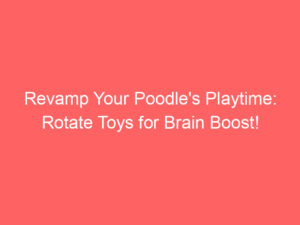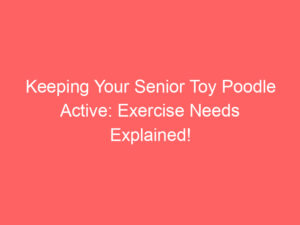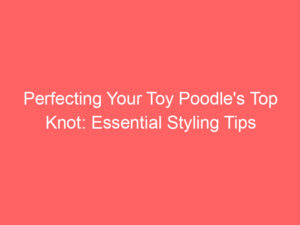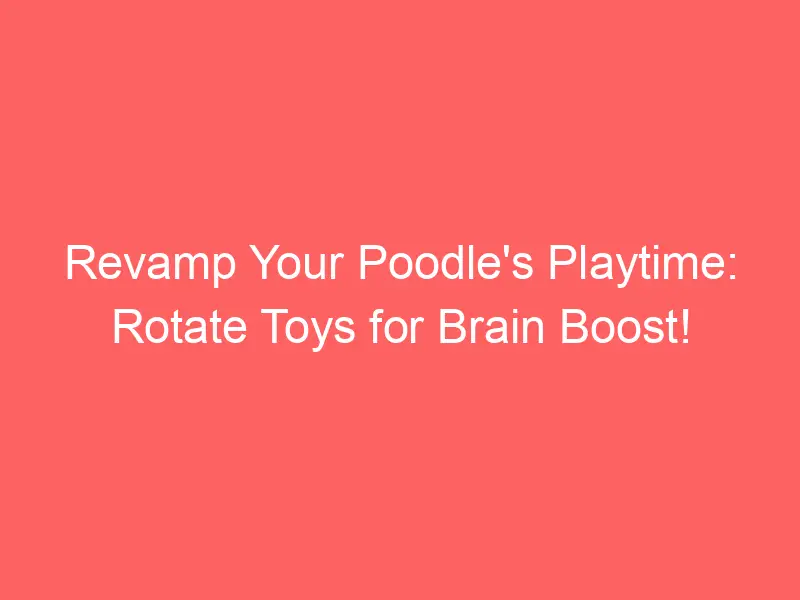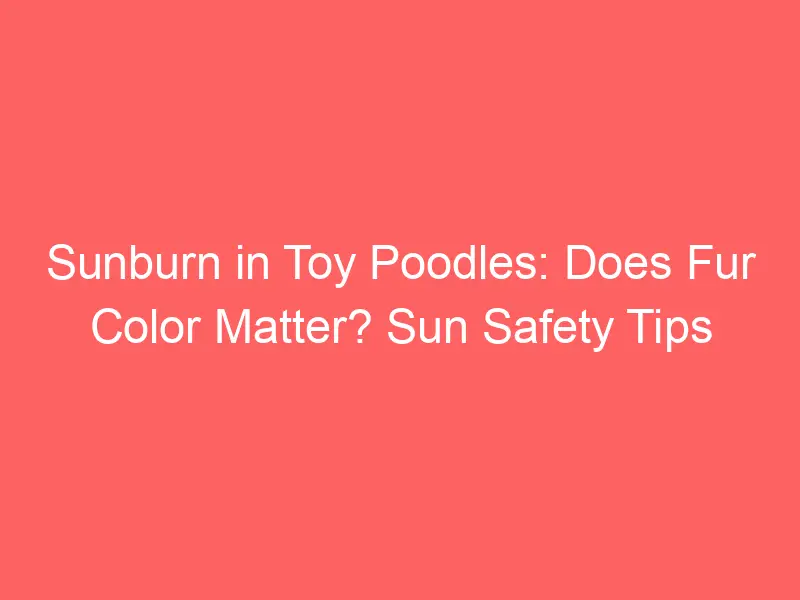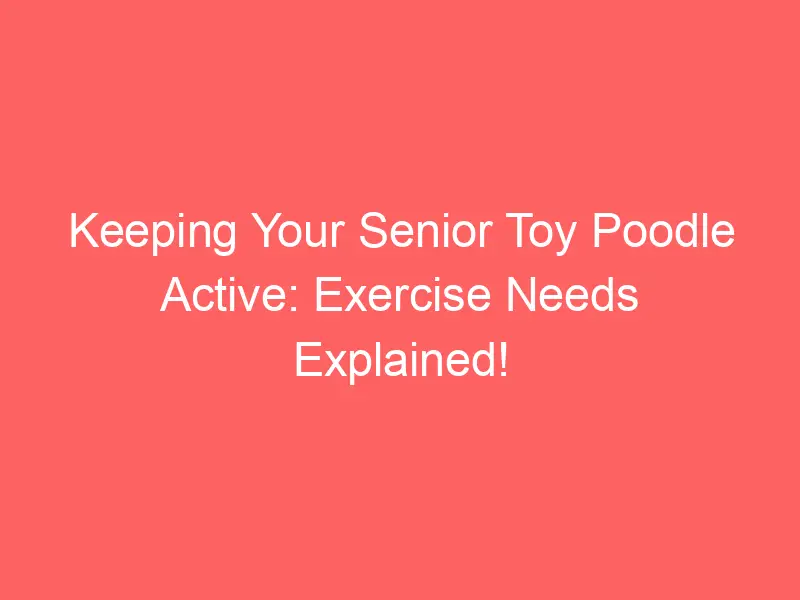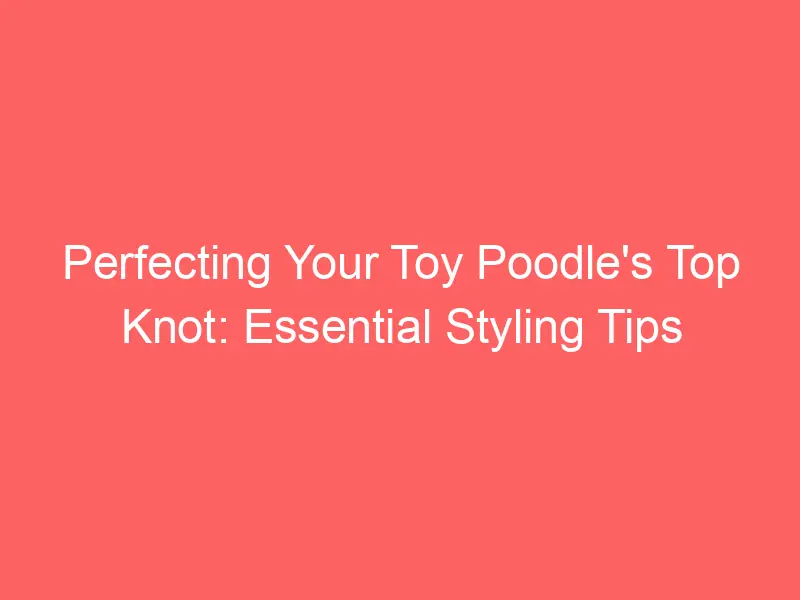
Understanding Toy Poodle Separation Anxiety
Separation anxiety is a common issue among dogs, and Toy Poodles are no exception. This condition can manifest in various ways, and understanding it is the first step towards helping your pet cope. In this section, we will define separation anxiety in dogs and discuss the specific traits of Toy Poodle anxiety issues.
- Definition of Separation Anxiety in Dogs
- Specific Traits of Toy Poodle Anxiety Issues
Separation anxiety in dogs refers to the distress experienced by a dog when separated from its owner or primary caretaker. This can result in a variety of behavioral issues, such as excessive barking, destructive behavior, and even self-harm. According to Wikipedia, separation anxiety is one of the most common behavioral problems in dogs, affecting approximately 20-40% of dogs in the United States alone.
Toy Poodles are known for their intelligence and strong bond with their owners, which can make them particularly susceptible to separation anxiety. They may exhibit behaviors such as excessive barking, chewing on furniture or personal items, and attempting to escape. Some Toy Poodles may also show physical symptoms, such as drooling, panting, or loss of appetite. It’s important to note that these behaviors can also be signs of other health issues, so it’s crucial to consult with a vet if you notice any changes in your Toy Poodle’s behavior.
Understanding your Toy Poodle’s anxiety issues is the first step towards helping them. In the following sections, we will discuss how to recognize signs of separation anxiety, its causes, and practical tips for coping with this condition.
Recognizing Signs of Separation Anxiety in Toy Poodles
Separation anxiety is a common issue among Toy Poodles. It’s important to recognize the signs early to help your furry friend cope. These signs can be categorized into two main types: behavioral signs and physical signs.
- Behavioral Signs
- Excessive Barking or Howling: If your Toy Poodle barks or howls more than usual when left alone, it could be a sign of separation anxiety.
- Pacing: An anxious Toy Poodle may pace in a fixed pattern when separated from its owner.
- Escape Attempts: Some Toy Poodles with separation anxiety may try to escape from the area where they are confined when left alone.
- Destruction: This can include chewing on furniture, scratching at doors, or tearing up items around the house.
- Physical Signs
- Excessive Drooling: This can be a sign of stress in Toy Poodles.
- Panting or Trembling: If your Toy Poodle pants or trembles when you’re about to leave, it could be a sign of separation anxiety.
- Changes in Appetite: Some Toy Poodles may eat less when they’re anxious.
- Accidents in the House: Even potty-trained Toy Poodles may have accidents in the house when they’re experiencing separation anxiety.
Behavioral signs are the most noticeable indicators of separation anxiety in Toy Poodles. These include:
Physical signs of separation anxiety in Toy Poodles are less obvious but equally important. These include:
Recognizing these signs is the first step in helping your Toy Poodle manage their separation anxiety. Remember, every dog is unique and may show different signs. If you notice any of these behaviors or physical changes, it’s important to consult with a professional for guidance.
Causes of Toy Poodle Separation Anxiety
Separation anxiety in Toy Poodles can be triggered by a variety of factors. One of the most significant contributors is genetic factors. Let’s delve deeper into this aspect.
Genetic Factors
Genetic factors play a crucial role in the development of separation anxiety in Toy Poodles. These factors can be broadly categorized into two types: hereditary traits and breed-specific traits.
- Hereditary Traits
- Breed-Specific Traits
Just like humans, dogs can also inherit certain traits from their parents. If a Toy Poodle’s parents or grandparents had separation anxiety, there’s a higher chance that the Toy Poodle might also develop the same condition. This is because the genes responsible for anxiety can be passed down from generation to generation. However, it’s important to note that heredity isn’t the sole cause of separation anxiety. Other factors can also contribute to this condition.
Some breeds, including Toy Poodles, are more prone to separation anxiety due to their specific traits. Toy Poodles are known for their intelligence and their strong bond with their owners. These traits make them more susceptible to separation anxiety. They crave companionship and can become distressed when left alone. Understanding these breed-specific traits can help in managing and preventing separation anxiety in Toy Poodles.
In conclusion, genetic factors can significantly contribute to the development of separation anxiety in Toy Poodles. However, it’s important to remember that these factors are just one piece of the puzzle. Other factors, such as environmental factors, can also play a role in this condition. By understanding these causes, we can better manage and prevent separation anxiety in our beloved Toy Poodles.
Environmental Factors
Environmental factors can significantly influence the development of separation anxiety in Toy Poodles. These factors can range from early life experiences to changes in routine or environment. Let’s delve into these aspects to understand them better.
- Early Life Experiences
- Changes in Routine or Environment
Early life experiences play a crucial role in shaping a Toy Poodle’s behavior. Puppies that have been separated from their mothers too early, or those that have experienced traumatic events, are more likely to develop separation anxiety. According to a Wikipedia article on dog behavior, puppies should ideally stay with their mothers until they are at least eight weeks old. This period is critical for their social development and can help prevent anxiety disorders in the future.
Toy Poodles thrive on routine and predictability. They can become anxious if there are sudden changes in their daily schedule or living environment. For instance, moving to a new home, a family member leaving or joining the household, or even a change in the time they are fed can trigger anxiety. It’s important to introduce changes gradually and give your Toy Poodle time to adjust. Remember, patience and consistency are key in managing your pet’s anxiety.
In conclusion, understanding the environmental factors that contribute to your Toy Poodle’s separation anxiety can help you take proactive steps to manage it. By providing a stable, nurturing environment and introducing changes gradually, you can help your Toy Poodle feel safe and secure.
Coping with Poodle Anxiety: Practical Tips
Dealing with anxiety in your Toy Poodle can be a challenging task. However, with the right approach and understanding, you can help your furry friend feel more secure and less anxious. One of the most effective ways to manage anxiety in Toy Poodles is by creating a safe space for them.
Creating a Safe Space
A safe space is a designated area in your home where your Toy Poodle can retreat to when they are feeling anxious or stressed. This space should be quiet, comfortable, and free from disturbances. Here are some tips to help you create the perfect safe space for your Toy Poodle:
- Choosing the Right Location: The location of the safe space is crucial. It should be a quiet area in your home where your Toy Poodle can relax without being disturbed. This could be a spare room, a corner of your living room, or even a large closet. Make sure the area is easily accessible for your Toy Poodle and away from high-traffic areas of your home.
- Providing Comforting Items: Fill the safe space with items that your Toy Poodle finds comforting. This could include their favorite toys, a soft blanket, or a piece of clothing that smells like you. These items can provide a sense of security and comfort to your Toy Poodle when they are feeling anxious.
Remember, the goal is to make your Toy Poodle feel safe and secure in their designated space. With time, patience, and consistency, your Toy Poodle will start to associate this space with comfort and safety, helping to reduce their anxiety levels.
Establishing a Routine
Establishing a routine is a crucial part of managing your Toy Poodle’s anxiety. A predictable schedule can provide comfort and security to your furry friend, reducing their stress levels. Let’s delve into two key elements of a successful routine: consistent feeding times and a regular exercise schedule.
- Consistent Feeding Times
- Regular Exercise Schedule
Feeding your Toy Poodle at the same times each day can help them feel secure and relaxed. Consistency in feeding times not only aids in digestion but also provides a sense of structure and routine. This can be especially beneficial in managing anxiety, as it gives your pet something predictable to look forward to each day. For example, you might feed your Toy Poodle once in the morning and once in the evening, at the same times each day. Remember, it’s not just about the timing – the quality of the food matters too. A balanced diet can contribute to your pet’s overall wellbeing, further helping to manage anxiety.
Exercise is another key component of a successful routine. Regular physical activity can help your Toy Poodle burn off excess energy, reducing anxiety and promoting a sense of calm. Aim for at least 30 minutes of exercise each day, whether that’s a walk around the block, a game of fetch in the backyard, or some indoor playtime. Remember to adjust the intensity and duration of the exercise based on your Toy Poodle’s age, health, and preferences. Regular exercise not only benefits your pet’s physical health but also their mental wellbeing, making it a vital part of managing anxiety.
In conclusion, establishing a consistent routine, including regular feeding times and a consistent exercise schedule, can go a long way in managing your Toy Poodle’s anxiety. Remember, every dog is unique, so it may take some time to find the routine that works best for your pet. Be patient, consistent, and flexible, and you’ll be on your way to a happier, less anxious Toy Poodle.
Poodle Anxiety Solutions: Training Techniques
Training your Toy Poodle to handle anxiety can be a challenging task, but with patience and the right techniques, it’s entirely possible. Here, we’ll explore two effective training methods: Desensitization and Counter-Conditioning Techniques.
- Desensitization Techniques
Desensitization is a process that involves gradually exposing your Toy Poodle to the source of their anxiety in a controlled setting. The goal is to reduce their fear response over time. For example, if your Poodle has separation anxiety, you might start by leaving the room for a few seconds, then gradually increase the time you’re away.
Here are some steps to follow:
- Identify the source of your Poodle’s anxiety.
- Start with short, manageable exposures to the anxiety source.
- Gradually increase the exposure time.
- Always ensure your Poodle feels safe and comfortable.
- Repeat the process consistently until your Poodle shows less anxiety.
- Counter-Conditioning Techniques
Counter-conditioning involves changing your Toy Poodle’s emotional response to the anxiety source. This method is often used in conjunction with desensitization. For instance, if your Poodle is anxious about being left alone, you might start by leaving for a short time and rewarding your pet with a treat upon your return. Over time, your Poodle will associate your absence with positive experiences, reducing their anxiety.
Here’s how to do it:
- Identify the anxiety trigger.
- Create a positive association with the trigger.
- Start with small, manageable exposures to the trigger.
- Gradually increase the exposure while maintaining the positive association.
- Repeat the process until your Poodle’s anxiety decreases.
Remember, patience is key when using these training techniques. It may take time, but with consistency, your Toy Poodle can learn to manage their anxiety effectively. Always consult with a professional trainer or a vet if you’re unsure about the process or if your Poodle’s anxiety persists.
Managing Separation Anxiety in Poodles: Professional Help
When it comes to managing separation anxiety in your Toy Poodle, seeking professional help can be a game-changer. Let’s delve into how working with a professional dog trainer can help.
Working with a Professional Dog Trainer
Professional dog trainers are equipped with the knowledge and skills to address behavioral issues, including separation anxiety. They can provide structured training programs tailored to your Poodle’s specific needs.
- Benefits of Professional Training
- Finding the Right Trainer
There are numerous benefits to professional dog training. Firstly, trainers use proven techniques to reduce anxiety and promote positive behavior. They can also provide guidance on how to maintain these behaviors at home. Secondly, professional training can strengthen the bond between you and your Poodle, fostering a sense of security that can help alleviate anxiety. Lastly, trainers can provide ongoing support and advice, helping you navigate any future challenges.
Finding the right trainer for your Toy Poodle is crucial. Look for trainers who are certified and have experience dealing with separation anxiety. Ask for references and speak to other clients to gauge their satisfaction. It’s also important to find a trainer who uses positive reinforcement methods and who makes both you and your Poodle feel comfortable. Remember, the goal is to create a positive, stress-free environment for your Poodle.
In conclusion, professional dog training can be a powerful tool in managing your Toy Poodle’s separation anxiety. It provides structured, expert guidance and offers ongoing support. However, the key to success lies in finding a trainer who is a good fit for both you and your Poodle.
Consulting a Veterinary Behaviorist
When it comes to managing separation anxiety in Toy Poodles, professional help can be invaluable. One of the professionals you may need to consult is a veterinary behaviorist. They are equipped with the knowledge and skills to help address your pet’s anxiety issues. Let’s delve into when to seek veterinary help and understand behavioral medication.
- When to Seek Veterinary Help
- Understanding Behavioral Medication
It’s crucial to know when to seek veterinary help for your Toy Poodle’s separation anxiety. If your pet’s anxiety symptoms persist despite your best efforts, it may be time to consult a professional. Signs that your dog may need professional help include excessive barking, destructive behavior, and extreme fear or distress when left alone. If these behaviors are consistent and severe, it’s time to seek veterinary help. A veterinary behaviorist can provide a comprehensive treatment plan that includes behavior modification techniques and, if necessary, medication.
Behavioral medication can play a significant role in managing separation anxiety in Toy Poodles. These medications work by altering certain chemical levels in your dog’s brain, helping them feel calmer and less anxious. It’s important to note that these medications are not a cure-all. They are most effective when used in conjunction with behavior modification techniques. Your veterinary behaviorist will guide you on the appropriate medication, dosage, and duration for your pet.
Remember, every Toy Poodle is unique and what works for one may not work for another. It’s essential to work closely with your veterinary behaviorist to find the best approach for managing your pet’s separation anxiety.
Reducing Anxiety in Toy Poodles: Lifestyle Changes
When it comes to managing anxiety in Toy Poodles, lifestyle changes can play a significant role. By focusing on two key areas – increasing physical activity and improving diet – you can help your furry friend lead a happier, less anxious life.
- Increasing Physical Activity
Physical activity is crucial for a Toy Poodle’s overall health and well-being. Regular exercise not only keeps your poodle physically fit but also helps to reduce anxiety. According to Wikipedia, dogs that get sufficient exercise are less likely to develop behavioral problems, including anxiety.
Try to incorporate at least 30 minutes of exercise into your Toy Poodle’s daily routine. This could be a brisk walk around the neighborhood, a game of fetch in the park, or even a fun agility course at home. Remember, the goal is to keep your poodle engaged and active, which can help to alleviate anxiety.
- Improving Diet
What your Toy Poodle eats can also impact their anxiety levels. A balanced, nutritious diet is essential for maintaining your poodle’s health and reducing anxiety. Certain foods can even help to calm your poodle’s nerves.
Consider incorporating foods rich in Omega-3 fatty acids, such as fish and flaxseeds, into your poodle’s diet. These nutrients have been shown to have a calming effect on dogs. Additionally, avoid feeding your poodle foods that are high in sugar or caffeine, as these can increase anxiety levels.
Remember, every Toy Poodle is unique, and what works for one may not work for another. It’s always best to consult with your vet before making any significant changes to your poodle’s diet or exercise routine.
In conclusion, by increasing physical activity and improving diet, you can make significant strides in reducing your Toy Poodle’s anxiety. These lifestyle changes, combined with other strategies such as training techniques and professional help, can help your poodle lead a happier, less anxious life.
Toy Poodle Anxiety Treatments: Natural Remedies
When it comes to managing anxiety in your Toy Poodle, there are several natural remedies that can be highly effective. These remedies are safe, gentle, and can often be used in conjunction with other treatment methods. Let’s explore two popular natural remedies: herbal supplements and aromatherapy.
-
Herbal Supplements
Herbal supplements can be a great way to help soothe your Toy Poodle’s anxiety. These supplements often contain ingredients like chamomile, valerian root, and passionflower, which are known for their calming effects. They work by promoting relaxation and reducing stress, helping your poodle feel more at ease.
It’s important to note that not all supplements are created equal. Always choose high-quality supplements from reputable brands. Also, remember to consult with your vet before starting any new supplement regimen. They can guide you on the correct dosage and ensure the supplement is safe for your poodle.
-
Aromatherapy
Aromatherapy uses essential oils to promote health and well-being. Certain scents, like lavender and chamomile, are known for their calming effects and can be beneficial for dogs with anxiety. You can use a diffuser to spread the scent throughout your home, or apply the oils to a bandana or toy for your poodle to sniff.
Remember, not all essential oils are safe for dogs. Always choose oils that are specifically formulated for pets, and avoid using too much as it can overwhelm your poodle. As with herbal supplements, it’s a good idea to consult with your vet before starting aromatherapy.
These natural remedies can be a great addition to your Toy Poodle’s anxiety treatment plan. However, they should not replace professional help if your poodle’s anxiety is severe or persistent. Always consult with a vet or a professional dog behaviorist for the best course of action.
Case Studies: Success Stories of Overcoming Toy Poodle Separation Anxiety
Let’s delve into some inspiring stories of Toy Poodles who have successfully overcome their separation anxiety. These case studies provide practical examples and valuable insights into the journey of managing and overcoming separation anxiety in Toy Poodles.
Case Study 1: Bella’s Journey
Meet Bella, a two-year-old Toy Poodle who used to suffer from severe separation anxiety. Bella’s owners, the Johnson family, noticed that she would become extremely anxious whenever they left the house, even for short periods. She would bark incessantly, chew on furniture, and even have accidents in the house.
Recognizing these signs of separation anxiety, the Johnsons sought help from a professional dog trainer. They also made several lifestyle changes to help Bella cope with her anxiety.
One of the key changes they made was to establish a consistent daily routine for Bella. This included regular feeding times, walks, and playtime. They also started using positive reinforcement training techniques, rewarding Bella for calm behavior when they were about to leave the house.
Over time, Bella’s behavior started to improve. She became less anxious when the Johnsons left the house and her destructive behaviors decreased. It was a slow process, but with patience and consistency, Bella was able to overcome her separation anxiety.
| Key Changes Made | Results |
|---|---|
| Consistent daily routine | Decreased anxiety |
| Positive reinforcement training | Reduced destructive behaviors |
Bella’s journey is a testament to the fact that with the right approach and consistent effort, it is possible to manage and overcome separation anxiety in Toy Poodles.
Case Study 2: Max’s Transformation
Meet Max, a lively Toy Poodle who had a severe case of separation anxiety. Max’s story is a testament to the power of patience, understanding, and the right approach to dealing with separation anxiety in Toy Poodles.
Max’s owner, Mrs. Johnson, noticed that Max would become extremely anxious whenever she left the house. He would bark incessantly, chew on furniture, and even have accidents despite being house trained. Mrs. Johnson was at her wit’s end and decided to seek professional help.
Initial Assessment
The professional dog trainer conducted an initial assessment and confirmed that Max was indeed suffering from separation anxiety. The trainer explained that Max’s behavior was not out of defiance or lack of training, but rather a manifestation of his fear and anxiety.
Implementing Changes
With the trainer’s guidance, Mrs. Johnson began implementing changes in Max’s routine. She started with small separations, gradually increasing the time Max spent alone. She also introduced clicker training to help Max associate her departures with positive experiences.
Results
After several weeks of consistent training and lifestyle changes, Max’s behavior began to improve. His barking reduced significantly, and he no longer chewed on furniture or had accidents. Mrs. Johnson was overjoyed with Max’s transformation.
| Before | After |
|---|---|
| Excessive barking | Significant reduction in barking |
| Chewing on furniture | No more destructive behavior |
| Accidents in the house | No more accidents |
Max’s story is a shining example of how understanding, patience, and the right approach can help a Toy Poodle overcome separation anxiety. It’s a reminder that our furry friends need our love and support to navigate through their fears and anxieties.
Key Takeaways: Conquering Separation Anxiety in Your Toy Poodle
As we conclude this comprehensive guide on managing separation anxiety in your Toy Poodle, let’s recap the most crucial points. These key takeaways will serve as your roadmap to help your furry friend overcome this challenging condition.
- Understanding is the First Step
- Patience and Consistency are Key
- Don’t Hesitate to Seek Professional Help
Recognizing and understanding the signs of separation anxiety in your Toy Poodle is the first step towards helping them. Symptoms can include excessive barking, destructive behavior, and restlessness when left alone. Understanding that these behaviors are not a sign of disobedience, but rather a cry for help, is crucial. Separation anxiety is a serious condition that can significantly affect your pet’s quality of life.
Overcoming separation anxiety in your Toy Poodle will not happen overnight. It requires patience, consistency, and a lot of love. Regular training sessions, gradual desensitization, and positive reinforcement are all crucial elements of this process. Remember, every small victory is a step in the right direction.
If your Toy Poodle’s separation anxiety symptoms persist or worsen, don’t hesitate to seek professional help. A professional dog trainer or a veterinary behaviorist can provide valuable insights and tailored strategies to help your pet. Remember, there’s no shame in seeking help. Your pet’s well-being is the top priority.
In conclusion, conquering separation anxiety in your Toy Poodle is a journey that requires understanding, patience, consistency, and sometimes professional help. But with love and dedication, you can help your furry friend lead a happier, anxiety-free life.

